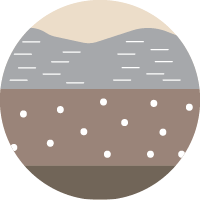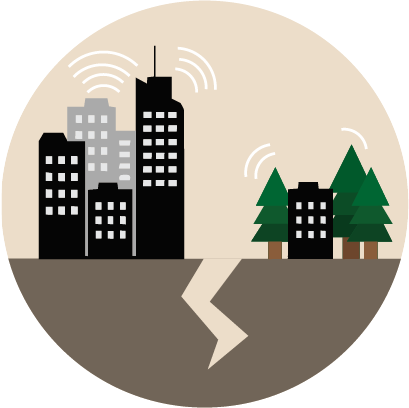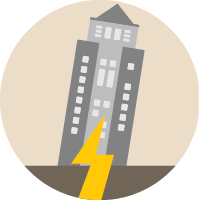How to compile earthquake risk?
In order to determine the earthquake risk, information on the density of buildings and people (exposure), the vulnerability of the built environment, and robust earthquake hazard assessments, including the impact of local soil conditions, are needed.
|
Earthquake hazard |

Earthquake hazard describes how often earthquakes trigger certain levels of ground shaking at a specific location. Earthquake hazard assessment considers the history of earthquakes in earthquake catalogues (databases), ground shaking models as well as geological and tectonic conditions. Robust earthquake hazard assessments are therefore a prerequisite of defining earthquake risk. Europe’s first earthquake risk model includes the data of the 2020 European Seismic Hazard Model, which is the updated version of the European earthquake hazard model. |
|
Local soil conditions |

The type of subsoil at a specific location or beneath a building has, in addition to the distance from the epicentre and the depth and magnitude of an earthquake, a significant influence on the expected ground shaking. The softer the ground, the more likely it is that ground shaking will be amplified, and damage will occur. The impact of the local soil conditions on the ground shaking is included in the earthquake risk calculations through a so-called regional site response model. This regional model uses slope (topography) and surficial geology as proxies for local site conditions, given that it would be far too complex and time-consuming to map in detail the properties of the soil across the whole of Europe. |
|
Exposure |

Earthquake risk can only occur where there are buildings and people (referred to as ‘exposure’). An area with a high level of earthquake hazard but with no exposure will not have any earthquake risk. In general, high-density, greatly developed areas like cities and urban areas have a higher concentration of exposure than rural regions and are thus subject to higher levels of earthquake risk. The exposure model used for the European earthquake risk model describes the spatial distribution and characteristics of around 145 million buildings and their occupants in 44 European countries. The model does not capture the details of every individual building, but instead provides an estimate of the buildings of different types (referred to as building classes) within the many administrative regions in each country. |
|
Vulnerability |

The characteristics of the buildings we spend our time in for leisure or work are important in defining earthquake risk. The better a house resists an earthquake, because, for example, it has been designed and reinforced accordingly, the less damage will occur if an earthquake occurs. Well-constructed buildings made from reinforced concrete and wood are generally able to withstand stronger earthquakes and are less vulnerable than brick buildings. Although most European countries have recent design codes and standards (Eurocode 8 and national codes) that ensure adequate protection from earthquakes, many older buildings still exist and they pose a high risk when earthquakes occur. In particular, at places with high earthquake hazard levels, unreinforced masonry housing (which is typically not designed using codes and has a more brittle behaviour than reinforced concrete, wood and steel) contributes significantly to the earthquake risk. Approximately 60% of reinforced concrete buildings in Europe have been seismically designed, but the quality of their seismic design depends on when and where they were built. The majority of older reinforced concrete buildings are still vulnerable to earthquake ground shaking and they are often an important driver of large economic losses and fatalities after an earthquake. |
Where to access data?
The risk.efehr platform operated by the EUCENTRE provides interactive access to the input data of the models’ components. In addition, the scientific data is accessible on the publicly available EFEHR GitLab repository for free download. Please observe the license and copyright information.
How to cite:
If you make use of the European Seismic Risk Model (ESRM20), please cite as follows:
H. Crowley, J. Dabbeek, V. Despotaki, D. Rodrigues, L. Martins, V. Silva, X. Romão, N. Pereira, G. Weatherill, L. Danciu (2021) European Seismic Risk Model (ESRM20). EFEHR Technical Report 002 V1.0.0, https://doi.org/10.7414/EUC-EFEHR-TR002-ESRM20
Explainer video
Would you like to learn more about earthquake risk and the difference between risk and earthquake hazard? Find answers in the explainer video!

